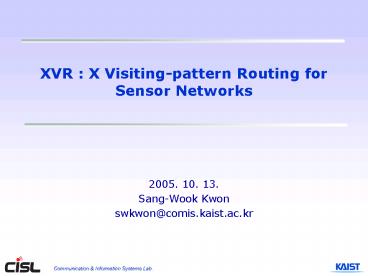XVR : X Visitingpattern Routing for Sensor Networks
1 / 23
Title:
XVR : X Visitingpattern Routing for Sensor Networks
Description:
Communication & Information Systems Lab. XVR : X Visiting-pattern Routing for Sensor Networks ... out of originator. ( static) Flooding : From originator to all ... –
Number of Views:25
Avg rating:3.0/5.0
Title: XVR : X Visitingpattern Routing for Sensor Networks
1
XVR X Visiting-pattern Routing for Sensor
Networks
- 2005. 10. 13.
- Sang-Wook Kwon
- swkwon_at_comis.kaist.ac.kr
2
Content
- Introduction
- Previous Work
- X Visiting-Pattern Routing
- Performance Evaluation
- Conclusion
- XVR X Visiting-pattern Routing for Sensor
Networks - Yu He Cauligi S. Raghavendra, INFOCOM 2005.
vol. 3, pp. 1758-1769, Mar. 2005.
3
Introduction(1)
- Sensor Networks
- Small, low-cost, and low-power devices.
- Packet Routing
- To forward an incoming packet to neighbor.
- Sensor network Routing
- Whether a sensor network routing needs to be
changed to accommodate application and network
dynamics. - Network dynamics
- Application resource discovery, monitoring
application - Heterogeneous network different subnet
4
Introduction(2)
- Motivation
- Existing routing services have limited
changeability. - Many routing services share essential properties
but with different visiting-pattern of packets. - Visiting-pattern where to forward packets as
next hops in a - network.
- Propose a general routing service for sensor
networks - Facilitates routing changes.
- Key idea decouple the visiting-pattern from the
routing core.
5
Previous work(1)
- Visiting-Pattern of Routing Services
- Where the packets go as next hop in a networks
- Need state information and forwarded packet.
- If no available state information,
visiting-pattern is fixed. - Routing service is classified roughly into two
categories. - Publication / subscription-based
- Forwarding-based
6
Previous work(2)
- The existing routing
- GPSR (Greedy Perimeter Stateless Routing)
- GEAR (Geographical and Energy Aware Routing)
- TBF (Trajectory Based Forwarding)
- Directed diffusion
- TTDD (Two Tier Data Dissemination)
- Rumor routing
7
Previous work(3)
8
XVR X visiting-Pattern Routing(1)
- XVR
- Decouple and parameterize visiting-patterns of
packets. - Assumption
- An attribute-based routing services.
- Not symmetric path, but can use symmetric path.
- Nodes are not location-aware, but can use the
location - knowledge if capable.
- Not mobile.
9
XVR X visiting-Pattern Routing(2)
- Architecture
- Visiting-patterns of packet types are specified
- XVR loads the corresponding packet handlers that
issue or forward packets according to their
visiting-pattern.
Routing Architecture Change with XVR
10
XVR X visiting-Pattern Routing(3)
- Packet type
- Subscription issued by sink to express its
interest. - Publication issued by source to announce data
availability. - Enforcement issued from source or sink to build
paths. - Hello issued by each node to collect neighbor
information. - Data issued by source that includes the actual
sensed data
11
XVR X visiting-Pattern Routing(4)
- Visiting-pattern
- Local A packet is sent not out of originator.
(static) - Flooding From originator to all nodes in
networks. (static) - Restricted-flooding The flooding with TTL
value. (static) - Probable-forwarding To decide if one neighbor
will become a - next hop with certain probability value.
(static) - Geographic-forwarding chooses next hop along
predefined - geographic curves. (static)
- Programmable-forwarding by consulting state
information and - packets at service runtime. (dynamic)
12
XVR X visiting-Pattern Routing(5)
- Supported visiting-patterns for each packet type
in the XVR
13
XVR X visiting-Pattern Routing(6)
- State maintained by the XVR
- Three packet types generate state
- Hello, Subscription, and Publication
- Hello
- Neighbor information state.
- Indexed by neighbor id, the latest timestamp.
- XVR decide what information to be collected from
neighbor by checking - visiting-pattern parameters.
14
XVR X visiting-Pattern Routing(7)
- Subscription
- Interest state
- Indexed by subscribed attributes and express
interest from neighbor - Interest state interested neighbor, latest
timestamp, enforced flag - Publication
- Available state
- Indexed by published attributes and express
availability from neighbor - Available state available neighbor, latest
timestamp, enforced flag
15
XVR X visiting-Pattern Routing(8)
- Algorithm
- Publication/subscription-based routing
- Three algorithm
- Before-meeting algorithm
- Meeting algorithm
- After-meeting algorithm
- Before-meeting algorithm
- Before a publication(subscription) packet reaches
a node with matched interest(available) state, it
is forwarded according to its visiting-pattern
parameter. - Passed nodes build or update available (interest)
state that constitutes pathes from sources(sinks)
to nodes.
16
XVR X visiting-Pattern Routing(9)
- Meeting algorithm
- When a publication(subscription) packet passes a
node with matched interest(available) state, one
copy of the matched publication packet is made
and marked as an after-meeting packet. - The original publication packet is continuously
processed as a before-meeting packet.
17
XVR X visiting-Pattern Routing(10)
- After-meeting algorithm
- After-meeting packet dont follow the specified
visiting-pattern parameter. - The marked publication packets follow paths in
interest state to reach - sinks using a new visiting-pattern.
- When the publication packets arrive at sinks,
enforcement packets - are issued from sinks.
- When the enforcement packets reach sources, route
from sources to sink is built.
18
Performance Evaluation
- Simulation Environment
- Using NS-2.
- of sensor node 100 in a 1500m 1500m
- Generation time of data packet every two
seconds - Simulation time 200 sec
19
Performance Evaluation
- Simulation Metric
- Dissipated Energy ratio
- Delay
- Delivery ratio
20
Performance Evaluation
- Simulation Result
21
Performance Evaluation
- Simulation Result
22
Performance Evaluation
- Simulation Result
23
Conclusion
- A general routing service for sensor networks
- Allows arbitrary visiting-patterns to be
specified independently from the routing core. - Enable routing changes
- Facilitates concurrent and automatic routing
services that adapt to different application and
network properties.































